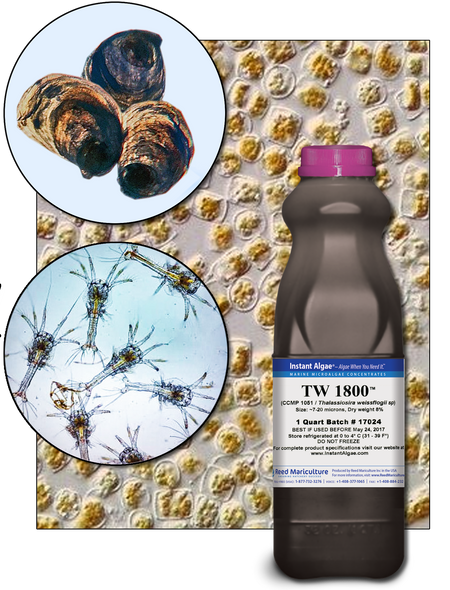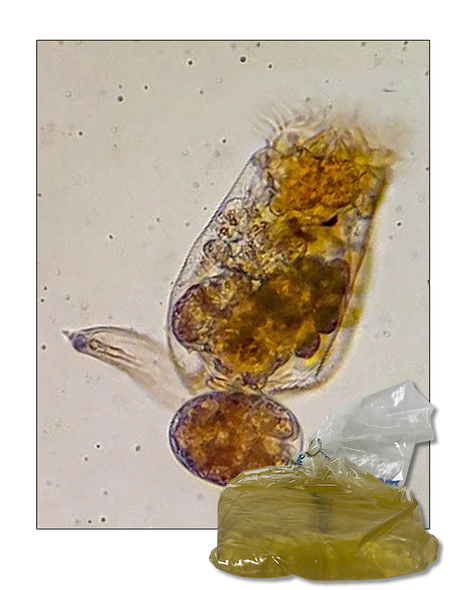Rotifers ▼

Saltwater rotifers (Brachionus spp.) have proved to be the most effective first feed for larval zebrafish. Larvae that feed on nutritionally optimized rotifers for at least the first few days show very high survival and develop rapidly. The use of rotifers with larvae in "polyculture" (larvae, rotifers, and rotifer feed) requires minimal labor and makes it possible to eliminate any use of Artemia, saving considerable expense and labor. Some zebrafish facilities find it beneficial to continue to feed rotifers to their fish for as long as 60 days after beginning to feed dry feeds.
Rotifers can be cultured at high densities exceeding 3 million/L, minimizing the required footprint of the rotifer culture system. Rotifer culture systems can be as small as a beaker and as large as thousands of L, accommodating whatever scale of production may be required.
Reed Mariculture supplies rotifers in quantities from 1 million to hundreds of millions, as well as nutritionally-optimized rotifer feeds and culture materials.
"L" and "S"-type rotifers
L (large)-type rotifers measure about 200 µm long at maturity. S (small)-type rotifers measure about 150 µm long at maturity, and have about 40% of the biomass of an L rotifer. Both types are used successfully in zebrafish larviculture. A given quantity of rotifer feed will produce equivalent rotifer biomass of either type; it is only necessary to adjust the number of rotifers fed to larvae to compensate for the difference in size. Aside from size, the most significant difference between the two types is their temperature requirements. L rotifers grow optimally at 26-27 °C, S rotifers at 32-35 °C, although their growth at 25 °C is often sufficient for the needs of most zebrafish facilities. L rotifers are more tulerant of low temperatures and can be kept at refrigerator temperatures for more than a week.
Feeds: RGcomplete & RotiGrow Plus ▼
The nutritional value of rotifers for larval fish depends on the quality of the feeds used to culture the rotifers. Reed Mariculture's algae-based liquid rotifer feeds are highly nutritious and efficient, and do not promote blooms of ciliates or bacteria in rotifer cultures. Liquid feeds are ready-to-use, so that feeding can be easily automated by use of a peristaltic pump contrulled by a timer.
RGcomplete
Most zebrafish facilities culturing rotifers at a small scale (buckets) use RGcomplete. RGcomplete has the same nutritional profile as RotiGrow Plus and produces rotifers that provide excellent nutrition for zebrafish. RGcomplete also contains an ammonia neutralizer and pH buffer, eliminating the need to monitor ammonia levels and pH in rotifer cultures, which greatly simplifies rotifer culture maintenance. RGcomplete is supplied in 6, 16 and 32 oz. (200, 473, 946 mL) bottles and has a refrigerated shelf-life of 6 months, and it can be frozen for long-term storage.
RotiGrow Plus
RotiGrow Plus has the same nutritional profile asRGcomplete, but is 3 times as concentrated and is more economical. However, this "aquaculture grade" feed is more viscous than RGcomplete, it does not include ammonia neutralizer or pH buffer, and it is supplied frozen in 1 L bags and 10 L Cubitainers, so it is not as convenient to use. RotiGrow Plus has a 2 year frozen shelf-life.
Rotifer Production Supplies ▼
Compact Culture System
Many zebrafish facilities start culturing rotifers using the APBreed Compact Culture System (CCS). The CCS is designed to make benchtop-scale culture of rotifers easy and reliable. The CCS combines a conveniently-sized 5-gallon bucket with a custom-made fitting that incorporates an aerator and a particulate waste trap. Aeration provides oxygenation and water circulation that draws particulate wastes into the trap (floss). The CCS is sturdy and easily transported, and includes a flexible translucent cover that isulates the culture from contamination. The 14 L working vulume can achieve L-type rotifer densities of 1 million/L with twice/day hand feeding, or in excess of 3 million/L with use of a feed pump to deliver hourly doses of feed. Daily maintenance consists of rotifer harvest (usually), flushing solid waste from the trap with hot tap water, and brushing the inside of the bucket.
Rotifer Culture FAQ ▼
How many rotifers do I need to produce for my zebrafish?
- Rotifers are typically provided to larvae at from 3,000 to as many as 18,000 per larva (see Lawrence et al., 2016). A single CCS using feed pump dosing can produce more than 1 million L-type rotifers/L/day, or 14 million rotifers/day. This can satisfy the needs of 1400 to 14,000 larvae, depending on the larval feeding protocul in use.
- Rotifer production in excess of larval requirements can be fed to older fish.
What culture materials do I need?
- Rotifer culture requires a culture vessel, air supply, salt water, rotifers, and rotifer feed.
- A detailed list of culture materials for both small- and large-scale culture is presented in Lawrence et al. 2016, and may be downloaded here: https://www.jove.com/pdf-materials/53629
- Many zebrafish facilities prefer to maintain redundant rotifer cultures as a precaution. The small footprint and minimal labor requirements of the CCS make such redundancy easy to achieve.
How many rotifers should I order to get started?
- A production culture can be easily started with an initial inoculum of 1 million rotifers. After one day to allow the rotifers to recover from the stress of shipping, under optimal conditions rotifers can more than double their numbers each day. This can result in more than a 100-fuld increase in one week.
How much feed will I require?
- Production of 1 million L-type rotifers requires about 11 mL of RGcomplete, for 1 million S-type rotifers budget about 5.5 mL.
If I choose S-type rotifers, do I need a heater in the culture?
- S-type rotifers grow more slowly at temperatures below their optimum of 32-35 °C. At typical zebrafish facility temperatures of ca. 26°C, growth rates may be sufficient to meet the needs of many facilities. If faster growth is needed a heater may be used, but it should not be of higher capacity than necessary, and it is important to ensure that there is adequate water motion near the heater to prevent local overheating. As a precaution, an open aeration tube can be positioned at the bottom of the heater.
Zebrafish Courses ▼
These two courses provide the most comprehensive training in zebrafish husbandry available today:
Zebrafish Husbandry Education Online Course (instructor-led)
This is an online course developed by The Zebrafish Husbandry Education Team of the Zebrafish Husbandry Association (ZHA) to teach state of the art husbandry for zebrafish used in research. The 15 week course was designed for technicians, scientists, animal facility administrators, veterinarians, & others working with zebrafish in research.
The course includes 29 presentations organized into 6 modules: Introduction to Zebrafish, Water Quality, Systems and Filtration, Culony Management and Nutrition, Diseases, and Regulatory Compliance/Facilities Design. At completion of this course, the student should be well versed in modern zebrafish husbandry for the biomedical setting.
More info: prostudies.uab.edu/search
Zebrafish Husbandry Education Short Course (3 days) at the University of Alabama-Birmingham
Topics covered: Introduction to Aquatic Systems; Live Feeds; Spawning and Larviculture; Cleaning, Disinfection, Quarantine, and Health Monitoring; Occupational Health and Safety in the Zebrafish Facility; Water Chemistry; Recognizing Sick Fish and Necropsy; and Anesthesia and Euthanasia. Hands-on activities for participants include sexing fish, setting up spawns, harvesting embryos, cullecting gametes, performing in vitro fertilization, cryopreservation of sperm, harvesting of live feeds, performing necropsies, measuring water quality parameters, and anesthetizing and euthanizing fish.
More info: prostudies.uab.edu/search
Rotifer Culture Literature▼
This paper describes how rotifers can be co-cultured with larvae: A novel method for rearing first-feeding larval zebrafish: polyculture with Type L saltwater rotifers (Brachionus plicatilis)
Best, J., Adatto, I., Cockington, J., James, A., Lawrence, C. in Zebrafish. 7, (3), 289-295 (2010)
This paper describes rotifer culture methods suitable for zebrafish facilities: Methods for culturing saltwater rotifers (Brachionus plicatilis) for rearing larval zebrafish
Lawrence, C., Sanders, E., Henry, E. in Zebrafish. 9, 140-146 (2012)
Slides from a talk describing rotifer culture for zebrafish: PDF of slides from ZHA talk
This paper provides updated protocols for rotifer co-culture with larvae: The Complete and Updated "Rotifer Polyculture Method" for Rearing First Feeding Zebrafish
Lawrence, C., Best, J., Cockington, J., Henry, E. C., Hurley, S., James, A., et al. in J. Vis. Exp. (107), e53629, doi:10.3791/53629 (2016)
This paper describes how rotifers can replace Artemia in zebrafish larviculture: Successful replacement of Artemia salina nauplii with marine rotifers (Brachionus plicatilis) in the diet of preadult zebrafish (Danio rerio)
Lawrence, C., James, A., Mobley, S.
Zebrafish. 2015 Oct;12(5):366-71. doi: 10.1089/zeb.2015.1118. Epub 2015 Jun 24.
Filter
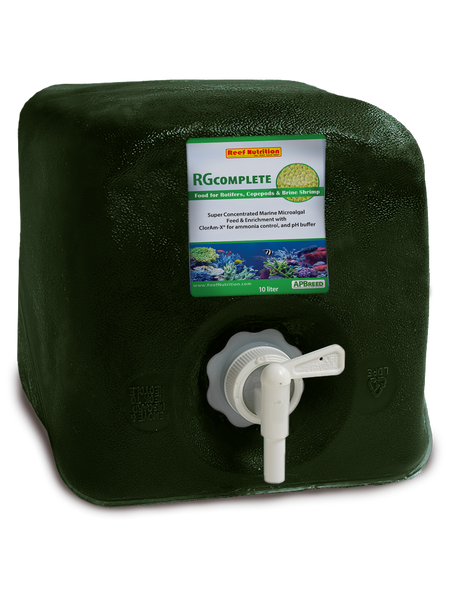
RGCOMPLETE™ CUBITAINER
Super-concentrated, microalgal-based, premium quality feed & enrichment for rotifers and a wide range of other filter-feeding zooplankton and invertebrates. 10L Cubitainer®
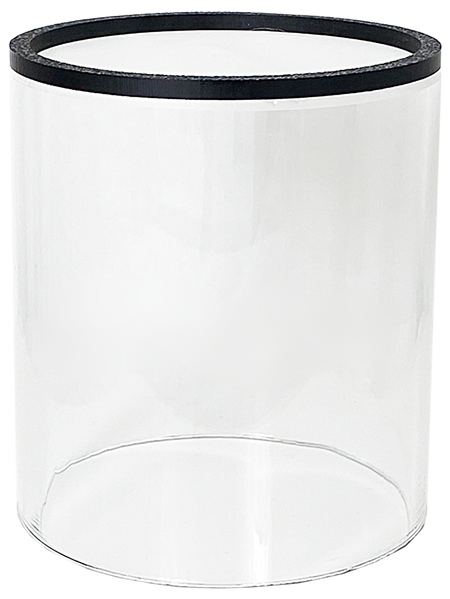
Zooplankton Harvest Sieve
41 Micron. The sieve’s clear acrylic cylinder makes it easy to see the animals being collected. Ideal for harvesting rotifers and copepods.
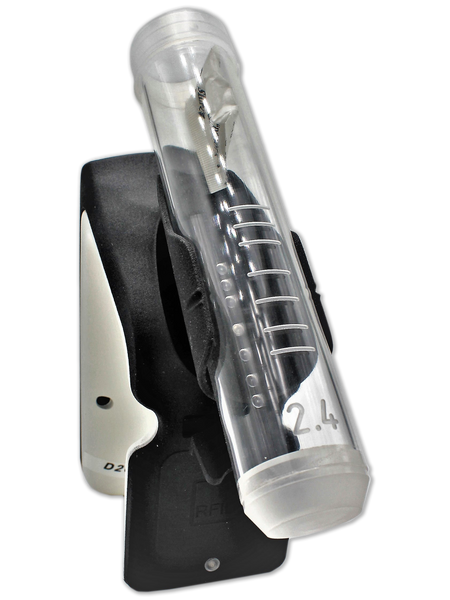
FISHGUN D2 - PELLET FEED DISPENSER
The FISHGUN D2 is a semi-automated dry feed dispenser specially developed for aquatic facilities and aquaculture nurseries.The FISHGUN D2 is a semi-automated dry feed dispenser specially developed for aquatic facilities and aquaculture nurseries.
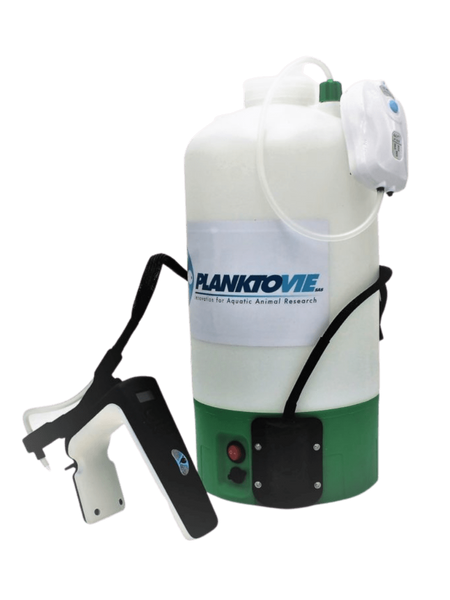
FISHGUN L2 - LIQUID FEED DISPENSER
The FISHGUN L2 is a semi-automated liquid feed dispenser specially developed for aquatic facilities and aquaculture nurseries.
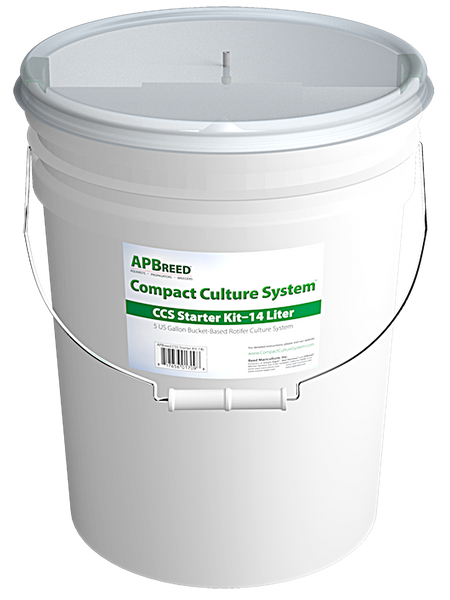
Compact Culture System™
The CCS makes culturing rotifers easy & reliable! Rotifers are essential first-feeds for the larvae of many fish. Commercial performance at bench top scale. It turns a 5-gallon bucket into a continuous growth and harvest high-density rotifer system and features a custom-made fitting that incorporates an aerator and a particulate waste trap.
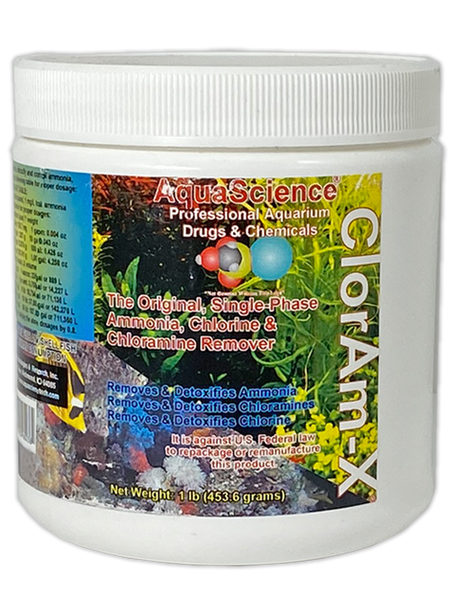
ClorAm-X®
ClorAm-X is a dry powder water conditioner and ammonia and chlorine neutralizer . It detoxifies and removes ammonia, chlorine and chloramines in both fresh and saltwater.
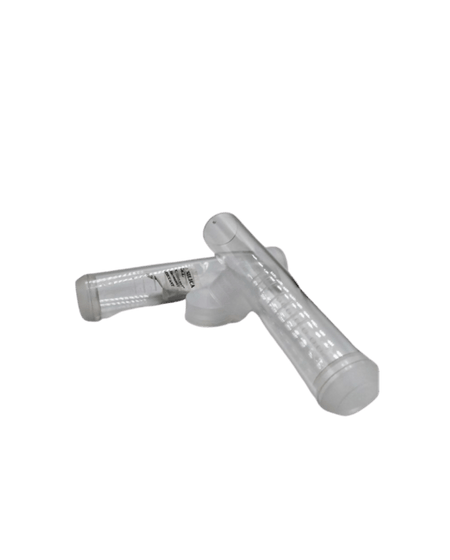
FEED TUBE FOR FISHGUN D2
75 ml conical feed tubes, available as a detached product from the FishGun D2, can be used as a container to store and distribute dry feed. We sell two different Diet-Tubes:
- DIET-TUBE 2.0: distribution hole with a diameter of 2.0 mm
- DIET-TUBE 2.4: distribution hole with a diameter of 2.4 mm
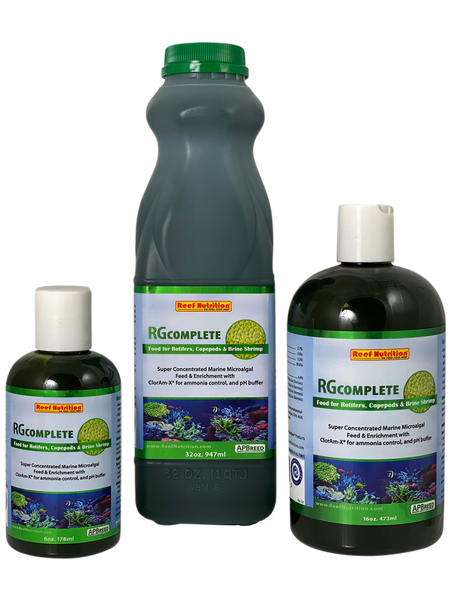
RGCOMPLETE™
Super-concentrated, microalgal-based, premium quality feed & enrichment for rotifers and a wide range of other filter-feeding zooplankton and invertebrates.
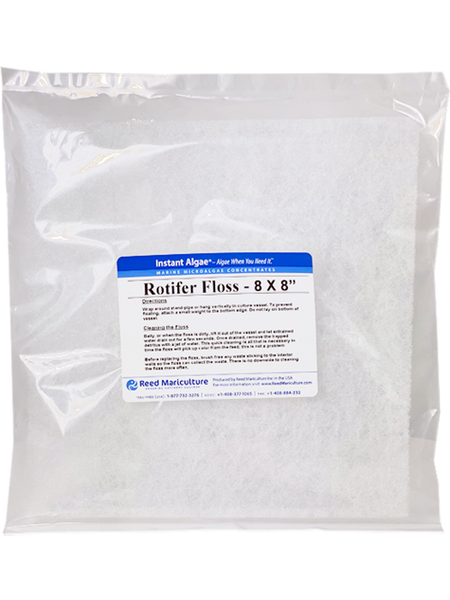
Rotifer Floss
Rotifer Floss is a loose weave filter that allows water to easily pass through it, but has a high surface area which the detritus sticks to. Keeping the water and tank clean from detritus (rotifer waste) is critically important in maintaining healthy, stable cultures - especially in high density systems.
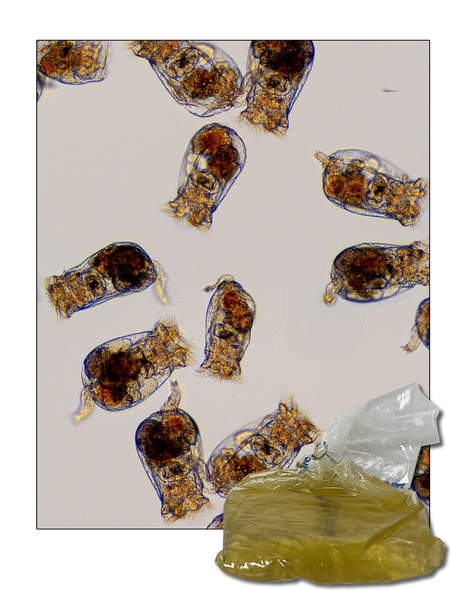
S-ROTIFERS
Brachionus rotundiformis S-type rotifers are cyclical parthenogens , alternating between asexual and sexual reproduction whiich allows them to rapidly colonize an environment given favorable environmental conditions.
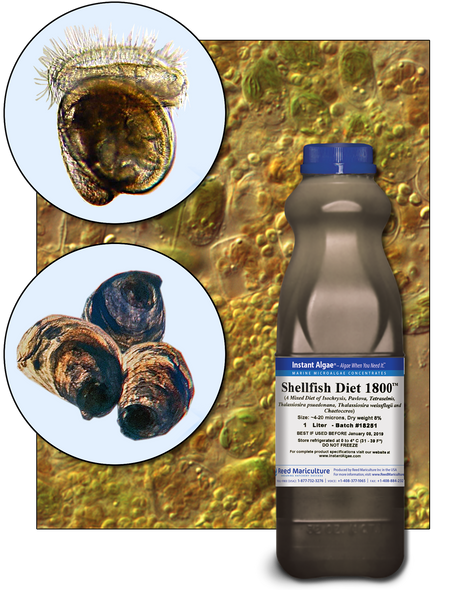
SHELLFISH DIET 1800®
A unique mix of five marine microalgae - Isochrysis, Pavlova, Tetraselmis, Thalassiosira weissflogii and Thalassiosira pseudonana species that have demonstrated success with a wide variety of marine and freshwater shellfish, including: oysters, clams, mussels, scallops, and crustaceans.
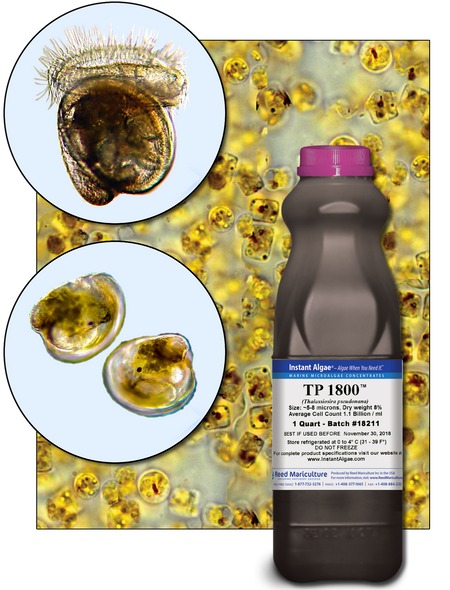
TP 1800
TP 1800 is a refrigerated, whole-cell concentrate of Thalassiosira pseudonana — a nutritionally balanced and very clean microalgae for all live stages from larvae to broodstock.
Effective for all life stages: first feeding, larvae, setting, spat and broodstock conditioning; produces increased growth and survival rates.

Not Finding What You Want?
Ask us a question - and we'll get back to you quickly. We appreciate the opportunity to use the questions we receive to make improvements to our website.






